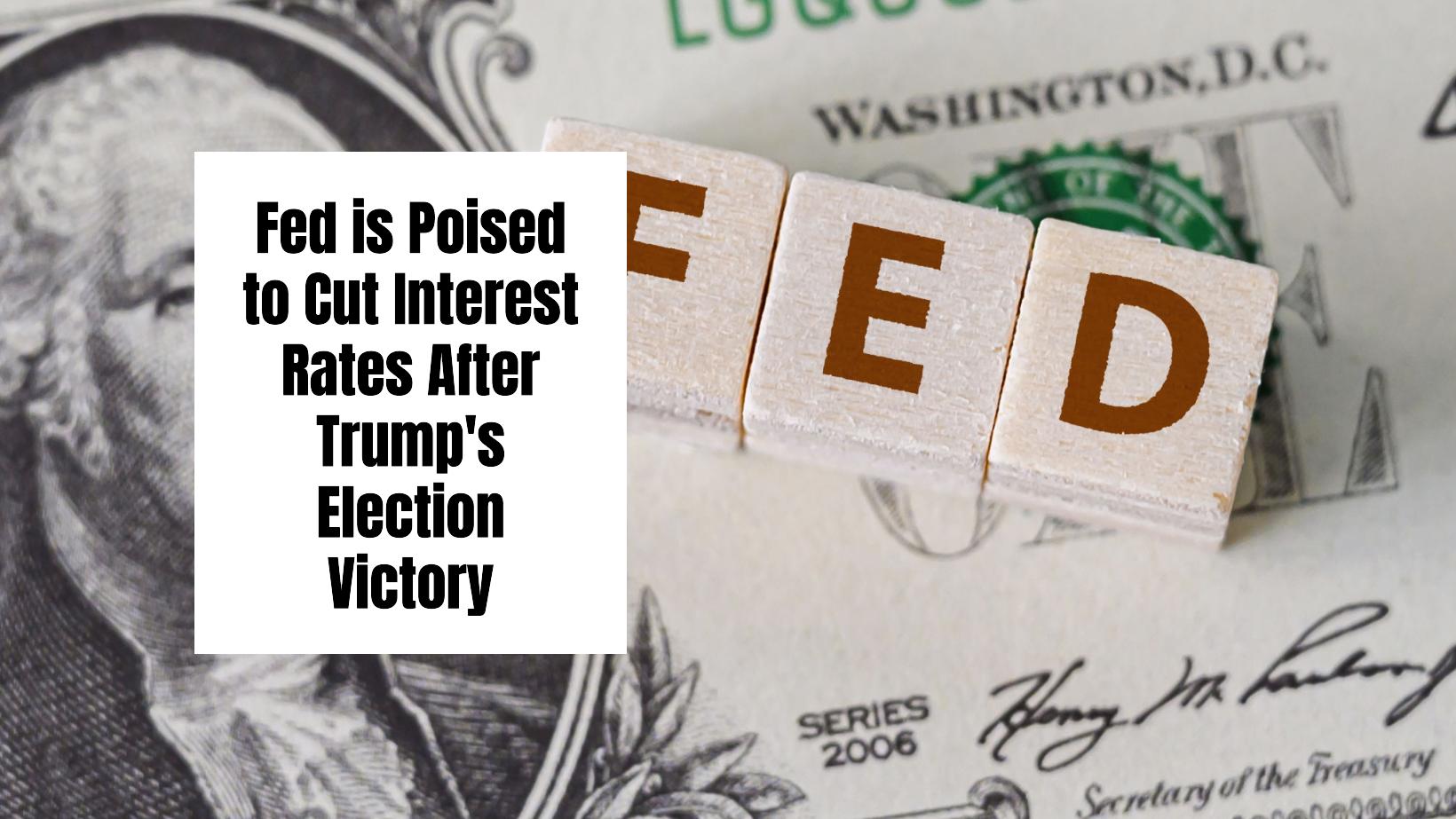The Federal Reserve is poised to cut interest rates following Donald Trump's recent electoral success. With the political shift bringing uncertainty into the economic scene, financial markets anticipate a 25 basis point reduction in interest rates, adjusting the target range to between 4.50% and 4.75%. This forecasted cut is even more pronounced when considering that markets have virtually locked in this adjustment, showcasing a collective sentiment around the Fed’s direction as it navigates the new political climate.
Federal Reserve Poised to Cut Interest Rates After Trump's Election Victory
Key Takeaways
- Interest Rate Cut Expected: Anticipation of a 25 basis point cut from the Federal Reserve.
- Markets React: Traders predict a shift in the Federal Reserve's policy due to Trump’s presidency.
- Inflation Concerns: Economic policies proposed by Trump could potentially reignite inflation.
- Future Uncertainty: The long-term path for interest rates remains unclear and contingent on the evolving economic landscape.
Donald Trump's victory in the presidential election has sent ripples through the economic environment of the United States. The Federal Reserve, which serves as the central bank of the U.S., plays a pivotal role in managing monetary policy, and its decisions are closely scrutinized by economists, markets, and politicians alike.
Traditionally, the Fed adjusts interest rates to foster economic stability—raising rates to combat inflation and lowering them to stimulate growth. However, navigating through a political and economic storm, the Fed's latest move to lower its target interest rate is complemented by the unpredictability that comes with Trump's leadership style and proposed policies.
Meeting Dates and Details:
Details:
- This is a two-day FOMC meeting.
- The meeting will focus on discussions regarding interest rate adjustments, with expectations of a rate cut being a central topic.
- A press conference with Fed Chair Jerome Powell will follow the meeting on November 7 at 2:30 PM ET.
- The minutes from this meeting will be released three weeks later, providing insights into the discussions and decisions made by the committee.
| Date | Event | Time | Key Notes |
|---|---|---|---|
| November 6, 2024 | FOMC Meeting Day 1 | All Day | Discussion on monetary policy |
| November 7, 2024 | FOMC Meeting Day 2 – Rate Decision | 2:00 PM ET | Press conference with Fed Chair at 2:30 PM ET |
The Current Economic Context
As the Federal Reserve prepares for its scheduled meeting, countless indicators suggest that a rate cut is imminent. Following September's inflation report indicating a rate of 2.4%, the Fed has managed to bring inflation down significantly from its peak of 9.1% in 2022. The low unemployment rate of 4.1% shows a resilient labor market, which is crucial for economic health. Nonetheless, the recent political developments have injected a degree of uncertainty that cannot be overlooked.
Many Fed officials believe that the cautious approach they've been taking—often termed “recalibrating”—is essential to maintain economic growth without triggering a recession. This means they aim for what is known as a “soft landing,” where inflation is kept in check while the economy continues to function effectively.
Market Expectations and Reactions
The reaction of the financial markets, particularly the anticipatory movements seen in futures trading, highlights how deeply connected trader sentiments are to expectations surrounding the Fed's interest rate decisions.
With the CME Group's FedWatch tool confirming these market beliefs, it becomes clear that investors have significant confidence in the likelihood of a rate cut. The anticipation is not just for the immediate future; it’s informed by a broader view of the economy under a Trump administration.
Another critical element is the 10-year Treasury yield, which recently soared to about 4.45%. This rise reflects traders' expectations surrounding Trump's policies, specifically his pledges to implement tariffs, reduce taxes, and potentially deregulate industries.
Such measures, according to many economists, could lead to increased economic activity but may also incite inflationary pressures that would call for the Fed to adjust its strategies once again.
Trump's Economic Agenda and Its Implications
In his campaign, Trump advocated for radical changes to the economic structure. His stance on tariffs and fiscal policies signals a potential commitment to an inflationary environment that might challenge the Fed’s current monetary policies. Should Trump fulfill his proposals through a bipartisan effort in Congress, the powerful interplay between rising inflation and interest rates would become a central concern for the Fed going forward.
While the Fed has maintained its independence from political pressures over the years, Trump's assertive rhetoric regarding monetary policy and the Fed's interest rate actions may loom large over future discussions. The unprecedented nature of Trump's administration means that economic predictions are less certain than before, requiring careful maneuvering from the Federal Reserve's Board of Governors.
Future Interest Rate Path: A Murky Forecast
Despite the immediate expectation of the rate cut, what lies ahead in terms of future interest rate adjustments remains ambiguous. Traders have begun to express less confidence about further cuts after December, suggesting that markets are recalibrating their perspectives based on stronger-than-expected economic data. This revised outlook stems from the complicated scenario where Trump's economic policies may lead to sustained growth, thus softening the demand for more aggressive rate cuts.
Fed Chair Jerome Powell faces a challenging press conference post-decision, where he will likely be questioned on how the new political dynamics will influence the Fed's strategies. Critics from both sides of the political aisle have accused the Fed of catering to electoral cycles, but Powell is expected to reiterate that decisions are based on economic data, not political pressures.
The Implications for Average Americans
For everyday Americans, these shifts in interest rates can have significant implications. Lower interest rates generally mean more affordable loans for consumers, which can boost spending and economic activity. On the flip side, if inflation restarts its upward trajectory due to aggressive economic policies, consumers could find themselves in a situation where costs for goods and services spike, leading to a potential erosion of purchasing power.
Moreover, the housing market often responds to Fed actions regarding interest rates. Lower mortgage rates can incentivize home-buying, making home ownership within reach for more people, while also affecting the rental market. With most Americans keenly aware of these dynamics, the forthcoming decisions from the Federal Reserve will elicit reactions from homeowners, potential buyers, and renters alike.
Navigating Uncertainty in Policy Decisions
As the Federal Reserve prepares to announce its decision on rates, there is a palpable tension regarding future policies under Trump's leadership. The potential for both economic growth and renewed inflation introduces a layer of complexity that officials are searching to manage judiciously. The Fed's current approach, focusing on maintaining a delicate balance between stimulating growth and controlling inflation, will be tested in the months to come.
In summary, the outlook surrounding the Federal Reserve's decision-making process post-Trump's electoral victory brings to light numerous economic theories, market strategies, and real-world implications for everyday citizens. Drawing from historical perspectives and current economic indicators, it is evident that the Federal Reserve is positioned at a crossroads, navigating between the immediate need for action and the long-term ramifications of those decisions.
Recommended Read:
- Fed Funds Rate Forecast 2025-2026: What to Expect?
- How Low Will Interest Rates Go in the Coming Months?
- Fed Just Made a BIG Move by Slashing Interest Rates to 4.75%-5%
- Market Reactions: How Investors Should Prepare for Interest Rate Cut
- How Low Will Interest Rates Go in 2024?
- Interest Rate Predictions for the Next 3 Years: (2024-2026)
- Interest Rate Predictions for Next 2 Years: Expert Forecast
- Impact of Interest Rate Cut on Mortgages, Car Loans, and Your Wallet
- Interest Rate Predictions for Next 10 Years: Long-Term Outlook
- When is the Next Fed Meeting on Interest Rates in 2024?
- Interest Rate Cuts: Citi vs. JP Morgan – Who is Right on Predictions?
- More Predictions Point Towards Higher for Longer Interest Rates



